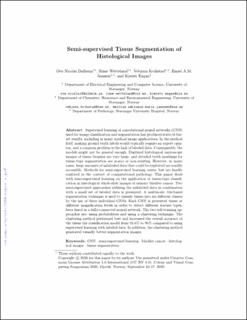| dc.contributor.author | Wetteland, Rune | |
| dc.contributor.author | Dalheim, Ove Nicolai | |
| dc.contributor.author | Kvikstad, Vebjørn | |
| dc.contributor.author | Janssen, Emiel | |
| dc.contributor.author | Engan, Kjersti | |
| dc.date.accessioned | 2021-04-28T07:56:19Z | |
| dc.date.available | 2021-04-28T07:56:19Z | |
| dc.date.created | 2020-10-21T15:29:24Z | |
| dc.date.issued | 2020-09 | |
| dc.identifier.citation | Dalheim, O.N., Wetteland, R., Kvikstad, V. et al. (2020) Semi-supervised tissue segmentation of histological images. Colour and Visual Computing Symposium 2020, Gjøvik, Norway, September 16-17, 2020 | en_US |
| dc.identifier.issn | 1613-0073 | |
| dc.identifier.uri | https://hdl.handle.net/11250/2740055 | |
| dc.description.abstract | Supervised learning of convolutional neural networks (CNN) used for image classification and segmentation has produced state-of-the art results, including in many medical image applications. In the medical field, making ground truth labels would typically require an expert opin ion, and a common problem is the lack of labeled data. Consequently, the models might not be general enough. Digitized histological microscopy images of tissue biopsies are very large, and detailed truth markings for tissue-type segmentation are scarce or non-existing. However, in many cases, large amounts of unlabeled data that could be exploited are readily accessible. Methods for semi-supervised learning exists, but are hardly explored in the context of computational pathology. This paper deals with semi-supervised learning on the application of tissue-type classifi cation in histological whole-slide images of urinary bladder cancer. Two semi-supervised approaches utilizing the unlabeled data in combination with a small set of labeled data is presented. A multiscale, tile-based segmentation technique is used to classify tissue into six different classes by the use of three individual CNNs. Each CNN is presented tissue at different magnification levels in order to detect different feature types, later fused in a fully-connected neural network. The two self-training ap proaches are: using probabilities and using a clustering technique. The clustering method performed best and increased the overall accuracy of the tissue tile classification model from 94.6% to 96% compared to using supervised learning with labeled data. In addition, the clustering method generated visually better segmentation images. | en_US |
| dc.language.iso | eng | en_US |
| dc.publisher | Colour and visual computing symposium / CEUR Workshop Proceedings | en_US |
| dc.rights | Navngivelse 4.0 Internasjonal | * |
| dc.rights.uri | http://creativecommons.org/licenses/by/4.0/deed.no | * |
| dc.subject | histologiske prøver | en_US |
| dc.subject | CNN | en_US |
| dc.subject | blærekreft | en_US |
| dc.title | Semi-supervised tissue segmentation of histological images | en_US |
| dc.type | Peer reviewed | en_US |
| dc.type | Journal article | en_US |
| dc.description.version | publishedVersion | en_US |
| dc.rights.holder | Copyright (c) 2020 for this paper by its authors. | en_US |
| dc.subject.nsi | VDP::Teknologi: 500::Medisinsk teknologi: 620 | en_US |
| dc.source.volume | 2688 | en_US |
| dc.source.journal | CEUR Workshop Proceedings | en_US |
| dc.identifier.cristin | 1841272 | |
| cristin.ispublished | true | |
| cristin.fulltext | original | |
| cristin.qualitycode | 1 | |

